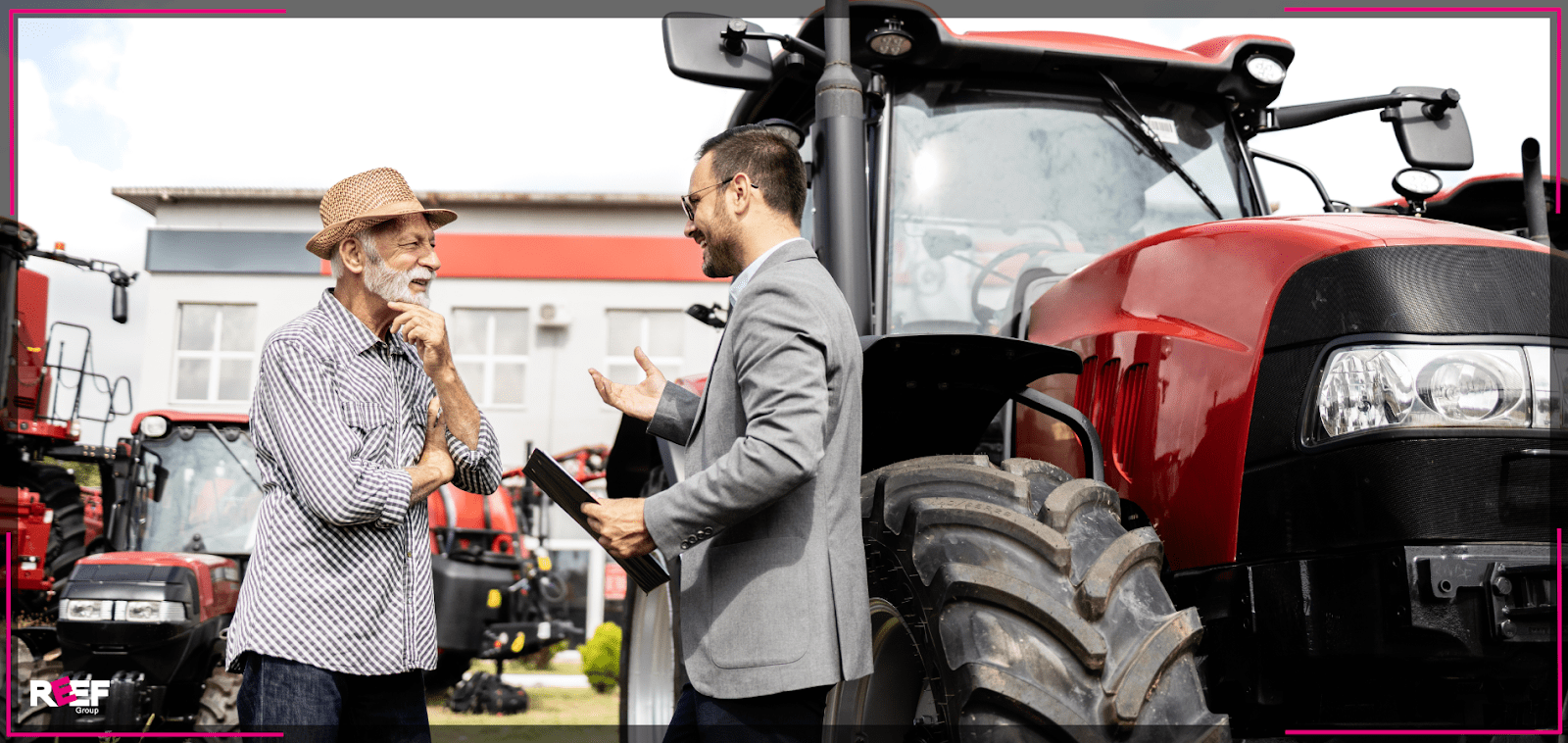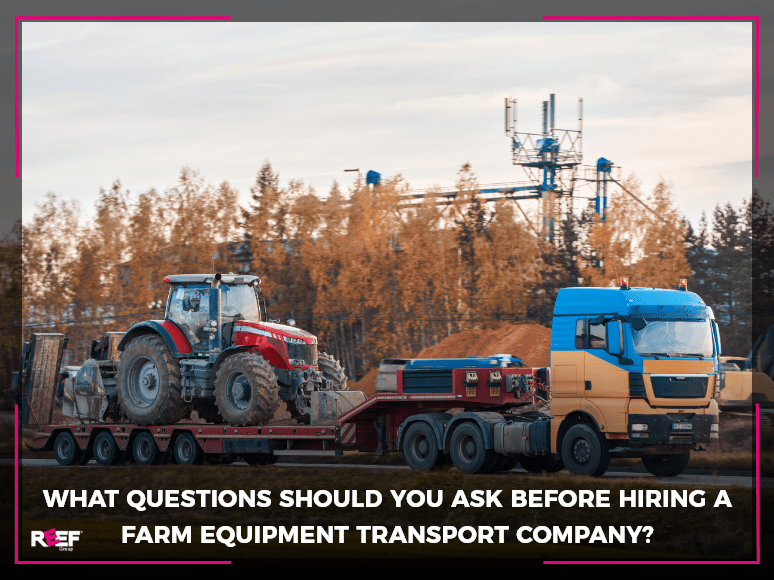What Checks Should You Do Before, During and After Transporting Farm Machinery?

What Questions Should You Ask Before Hiring a Farm Equipment Transport Company?
September 30, 2025
Getting your tractors, harvesters, and other farm machinery from A to B safely isn’t just good practice. It’s absolutely essential for keeping your operation running smoothly and protecting equipment that costs a fortune to replace.
When transport goes wrong, you’re looking at expensive delays, downtime that eats into your profits, and potential damage to equipment that might take weeks to repair. None of this is something any farmer can afford, especially during critical seasons.
Here’s the thing: most agricultural machinery is oversized and overweight compared to standard vehicles. This means you can’t just hitch it up to any trailer and hope for the best. You need the right equipment, proper permits, and a solid understanding of safety requirements. Get it wrong, and you could face hefty fines or, worse, cause an accident.
This guide walks you through everything you need to know about transporting agricultural machinery safely across Australia. We’ll cover the planning essentials, permit requirements, equipment selection, loading techniques, route planning, and the safety practices that’ll keep you legal and your machinery intact.
By following these steps, you’ll ensure your valuable equipment reaches its destination in one piece, on time, and without any nasty surprises along the way.
Define Your Transport Requirement
Start by getting crystal clear on exactly what you’re moving. Are you transporting a compact tractor, a massive combine harvester, or something in between like balers, mowers, or planters?
You’ll need the precise dimensions, total weight, and centre of gravity for each piece of equipment. This information directly impacts which vehicle you’ll need, how you’ll secure the load, and which routes you can safely take.
Check if your machinery is road-legal for short self-propelled movements. Does it meet Australian road lighting and signalling requirements? What about weight restrictions? If it doesn’t tick these boxes, or if you’re crossing certain road types, you’ll need professional transport.
Consider the journey itself. Rough unsealed roads, steep grades, or long-distance hauls often require more powerful trucks or specialised equipment like low loaders or tilt trays. Matching your machinery and terrain to the right vehicle setup reduces risk and ensures safe delivery.
Timing matters, especially during harvest periods. Schedule your transport to align with operational demands so you avoid costly downtime. Your machinery needs to be exactly where you need it, when you need it.
Getting this planning stage right prevents delays and sets the foundation for smooth, efficient transport of your agricultural equipment.
When to Use Professional Haulage Services
You’ll need professional haulage services when your machinery is oversized, overweight, high-value, or poses special risks during transport. This includes long-distance moves or challenging routes that exceed standard vehicle capabilities.
These situations require specialist equipment and experienced operators who understand compliance requirements and safety protocols. You’re not just paying for a truck, you’re buying expertise.
Professional services give you access to heavy-duty trailers, tilt trays, low loaders, and proper lifting gear. More importantly, you get operators who know how to load, secure, and transport complex machinery safely.
An experienced transport company in Perth will employ trained drivers who understand Australian regulations inside out. They handle route planning, risk management, and all the permits required for moving large agricultural machinery on our roads.
They also provide comprehensive insurance coverage. If something goes wrong during transit, your investment is protected from accidents or unexpected incidents.
Before you hire anyone, check their fleet includes the right equipment for your specific machinery. Look for winches, chains, ramps, and properly rated lifting equipment that matches your needs.
Proper selection protects your assets and ensures your transport meets all legal and safety standards. This minimises disruption and prevents costly delays that can derail your operations.
Preparing Agricultural Machinery for Transport
Service your agricultural machinery thoroughly before any move. Lubricate all moving parts and check for leaks, worn hoses, or mechanical defects that could cause breakdowns or spills during transport.
Remove or secure loose items like toolboxes, spare parts, or non-essential attachments. Extended arms, augers, and other components not needed for the journey should be detached completely or fastened tightly to prevent shifting or damage en route.
Fold down mirrors, steps, and headers where possible to reduce your machine’s overall height and width. This keeps you within legal transport limits and avoids costly delays from compliance breaches.
Protect sensitive components like electronics, exposed hydraulics, and glass surfaces with weatherproof coverings. Road debris, moisture, and dust can cause expensive damage that’s easily prevented with proper protection.
Check your manufacturer’s guidelines for specific preparation instructions. Every piece of machinery has unique requirements, and following these recommendations ensures your equipment arrives in working condition.
Load Securing and Stability
Secure your machinery properly to prevent movement during transit using chains, straps, and braces rated for your equipment’s weight. Fasten restraints at the manufacturer’s designated tie-down points, ensuring even tension and alignment across the trailer deck.
After loading, check all restraints for correct tension. Heavy machinery settles as you travel, so re-check and adjust tie-downs regularly throughout your journey.
Consistent load checks matter especially on long distances or rough roads. Without them, you risk shifting, tipping, or losing control completely.
Following these practices reduces equipment damage, enhances driver and road user safety, and keeps your transport compliant with Australian regulations. Your machinery and everyone on the road depends on getting this right.
Legal and Compliance Essentials
Oversize and overweight agricultural machinery movements in Australia are tightly regulated. Before transport, secure the necessary oversize or overweight permits specific to your route and state, as requirements can differ between jurisdictions.
For larger machinery, check if escort or pilot vehicles are mandated. These may be compulsory depending on the load’s dimensions and the transport corridor you’re using.
Proper visibility is essential. Fit all required warning signs and amber rotating or flashing lights to the load and transport vehicle, as prescribed by Australian road authorities.
Pay close attention to any legal restrictions on travel times, such as daylight-only movements or peak hour curfews, and plan your journey accordingly.
Only drivers and operators with the correct licence should be permitted to move agricultural equipment. You typically need a heavy vehicle class for public road use.
Confirm all staff meet licensing and qualification requirements before departure to avoid penalties or invalidated insurance. Ensuring compliance across these areas minimises the risk of fines, delays, and safety incidents during transport.
On‑Road Execution and Contingency Planning
Drive conservatively when moving agricultural machinery, especially considering the extended stopping distances that heavy and oversized loads require. Keep your speed appropriate for road conditions, weather, and your cargo’s weight.
Increase following distances significantly to allow for safe braking. Anticipate potential hazards well ahead of time rather than reacting at the last moment.
Use escort vehicles when local authorities require them, particularly for oversize transports. Escorts alert other road users, help manage traffic, and guide your convoy through tricky manoeuvres like turning or getting through narrow passages.
This becomes especially important on rural and regional roads, where other drivers might have limited visibility and reaction time.
Prepare for unexpected breakdowns or delays before you leave. Have a solid backup plan that covers alternative routes and emergency contacts.
Equip your team with essential tools, spare parts, extra fluids, and enough fuel to handle unforeseen stops. Quick access to these resources cuts downtime and keeps both your crew and valuable equipment safe.
Proper contingency planning reduces the risk of prolonged disruptions and keeps your transport operation on schedule.
Machinery‑Specific Guidance
Combine Harvesters and Other Harvesting Equipment
Choosing the right trailer makes all the difference when moving your combine harvesters and harvesting machinery. For combines under eight feet tall, flat-deck trailers offer excellent stability and straightforward loading.
Step-deck trailers work perfectly for intermediate-height equipment like balers. The lowered deck gives you the extra height clearance you need whilst keeping everything within legal transport limits.
Taller or particularly heavy combines require a removable gooseneck trailer to handle the additional mass properly and make loading much more manageable.
If you’re dealing with wider machinery bases, look for trailers equipped with sliding outriggers. These extend your available deck width, provide secure support for larger equipment, and make the entire loading process safer and more stable.
Peak harvesting seasons demand efficiency above everything else. Book your transport services well ahead of time and coordinate arrivals carefully to keep your equipment working continuously.
This approach prevents costly bottlenecks at the field, ensures your machinery arrives exactly when you need it, and helps maximise your harvest productivity when every hour counts.
Tractors and Common Farm Implements
Before moving your tractor anywhere, strip off or secure any attachments that aren’t essential for the journey. Front-end loaders, backhoes, and other implements just add unnecessary risk during transport if they’re not properly fastened.
Leaving non-essential gear attached increases the chances of movement and damage whilst you’re on the road. It’s much safer to remove what you don’t need entirely.
Make sure your trailer can handle the total weight of your tractor plus any remaining attachments. Check that all tie-down points line up properly between your trailer and machinery configuration.
Use correctly rated restraints at the designated tie-down locations. This keeps your load stable throughout the entire journey, which is absolutely crucial for safe transport.
For short, local moves within road-legal limits, you might consider driving the tractor itself. This only works if it’s fitted with proper lights, reflectors, and signalling equipment, and meets all state road regulations.
This approach is only suitable when your equipment passes safety requirements and roadworthiness standards for public roads. You’ll also need clear warning signals to alert other road users to your presence.
Pre‑Departure, En Route, and Arrival Checks
Before you hit the road, confirm all legal permits are sorted, your route has been checked for potential obstacles or restrictions, and the machine has been serviced according to manufacturer specifications. Strip off any loose or non-essential parts that could become hazards during transport.
Apply tie-downs, chains, or straps at the designated anchoring points and double-check every securing method. There’s no room for shortcuts here.
Choose the right trailer for your machine’s dimensions and weight. Flat-deck or low loader, plus ramps or lifting equipment that match the job. Check that all connectors and fittings are properly secured, and make sure the load sits evenly on the trailer for stable transit.
During transport, display clear warning signs and lights. Use escort vehicles when required, particularly for oversize loads. Stop regularly to check and re-tension chains and straps, especially after rough sections or sharp turns.
Stay ready to adjust your driving style for changing weather or road conditions. Your machinery’s safety depends on adapting to what’s ahead.
At your destination, conduct controlled unloading with the right personnel and equipment on hand. Inspect the machinery and tie-down points carefully for any signs of movement or damage from the journey.
Safely refit any previously removed attachments and reset machine features according to operational requirements. Make sure everything’s working properly before putting the equipment back into service.


